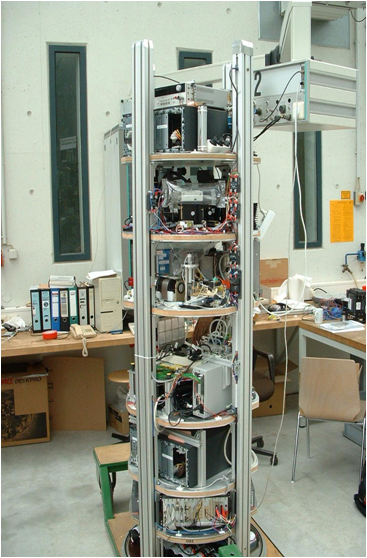investigation on aerosol particle motion caused by temperature (APM)

research area: astrophysics
experiment title:
Interactions in Cosmic and Atmospheric Particle Systems (ICAPS) - Investigation on Aerosol Particle Motion caused by Temperature
experiment acronym: APM
funding agency: ESA
grant number: AO-2000-064
performing organization:
Microgravity Research Center, Université Libre de Bruxelles, Belgium
prime investigator: Dr. Andrei Vedernikov
experiment objective
abstract
The aim of the work is getting reference data on thermophoretic motion eliminating gravity-induced perturbation, developing new instrumentation and procedures. A series of experiments on measuring phoretic velocities was performed in the Bremen drop tower providing 4.7 s of high quality microgravity conditions, which allowed making negligible particle sedimentation and buoyancy driven convection. Motion of aerosol particles was observed simultaneously at low resolution to control nongravity convective motion in the cell and at high resolution by the digital holographic velocimeter in order to register particle three-dimensional trajectories. By choosing appropriate cell size and experimental procedures the heat and mass transfer relaxation processes were reduced to less than 0.3 s thus allowing measurements of particle velocities during more than 4 s. Side-wall temperature creep created convective motion in the cell. Its influence was suppressed by choosing sufficiently flat cell geometry. The values of the measured thermophoretic velocities for Knudsen number in the range 0.047–0.89 were found to be between predictions of the classical models of Talbot et al. [J.Fluid Mech. 101, 737 (1980)] on one hand and Yamamoto and Ishiara [Phys. Fluids. 31, 3618 (1988)] on the other hand. Particles of different thermal conductivities (paraffin and NaCl) had about the same velocities. No negative thermophoresis was observed at these conditions for NaCl.
related publications
- Thermophoretic measurements in presence of thermal stress convection in aerosols in microgravity conditions of drop tower. A. Vedernikov, F. Prodi, G. Santachiara, S. Travaini, F. Dubois, J.C. Legros, Microgravity Sci. Technol., 2005, vol.17, N3, pp.102-105
- Digital holography for observing aerosol particles undergoing Brownian motion in microgravity conditions. F. Prodi, G. Santachiara, S. Travaini, F. Belosi, A. Vedernikov, F. Dubois, P. Queeckers, J.C. Legros. Atmospheric Research Journal, 2006, 82/1-2, pp. 379-384
- Measurements of phoretic velocities of aerosol particles in microgravity conditions. F. Prodi, G. Santachiara, S. Travaini, A. Vedernikov, F. Dubois, J.C. Legros. Atmospheric Research Journal, 2006, 82/1-4, pp. 183-189
- On the way of detecting the negative thermophoresis (results of microgravity experiments and gas-kinetic analysis). A. Vedernikov, S. Beresnev, A. Markovich. Journal of the Japan Society of Microgravity Application, 2008, vol. 25, No. 3, pp. 267-272
- Dust Particles in Space. J. Blum, A.-C. Levasseur-Regourd, O. Muñoz, R. J. Slobodrian, A. Vedernikov. Europhysicsnews, 2008, 39/3, pp. 27-29
experiment campaigns
experiment year: 2004
number of drops: 10
experiment year: 2003
number of drops: 32


 "
"